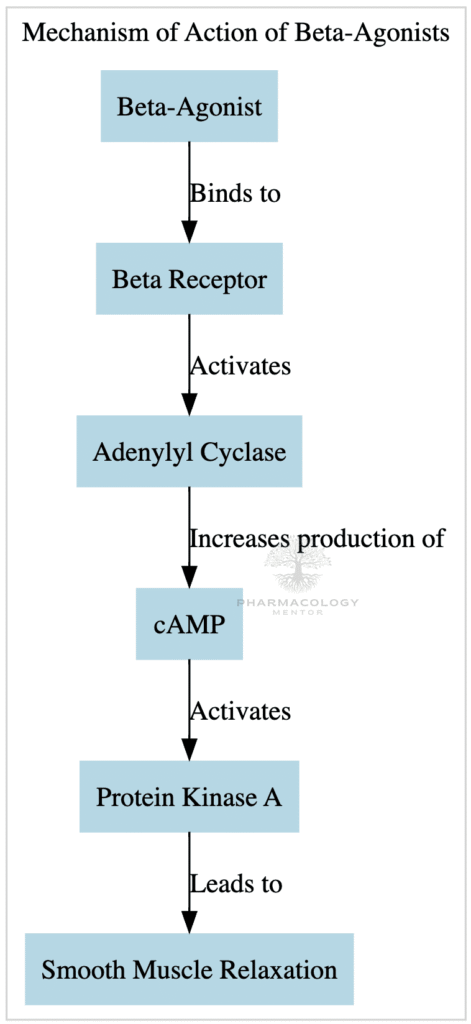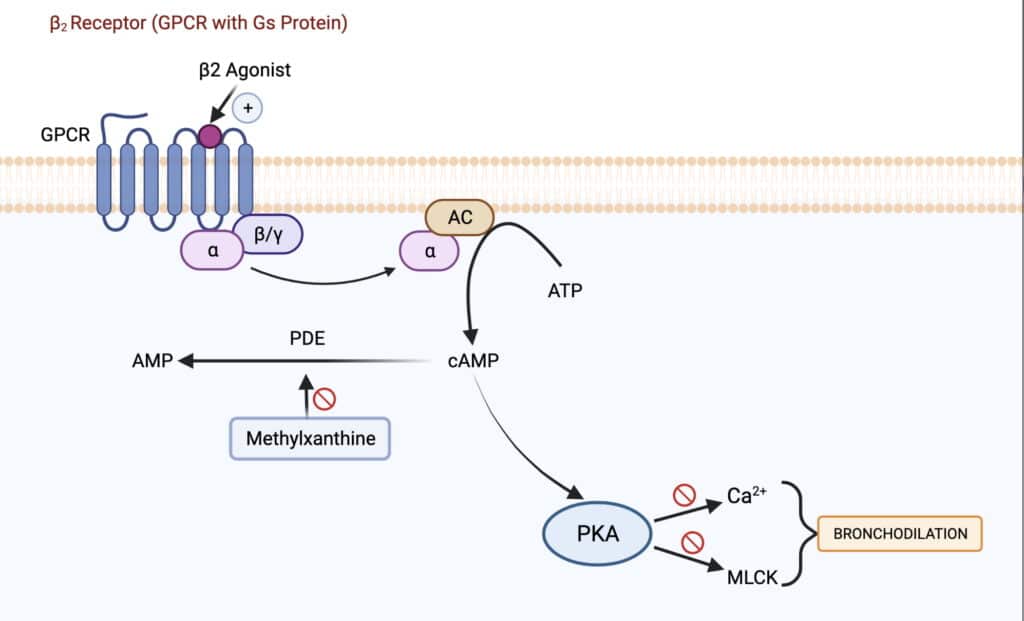Introduction to Beta-Agonists:
Beta-agonists are medications that stimulate beta receptors in the body. These receptors are found in various tissues, including the lungs, heart, and blood vessels. Due to their effects, beta-agonists are commonly used to treat conditions like asthma, chronic obstructive pulmonary disease (COPD), and certain heart conditions.
Classification of Beta-Agonists:
Short-Acting Beta-2 Agonists (SABAs):
- Usage: Used as “rescue” inhalers for immediate relief from acute asthma symptoms or COPD exacerbations.
- Examples:
- Albuterol (also known as Salbutamol in some regions)
- Levalbuterol
- Terbutaline
Long-Acting Beta-2 Agonists (LABAs):
- Usage: Used for long-term control and prevention of asthma symptoms and to manage COPD. They are often combined with inhaled corticosteroids.
- Examples:
- Salmeterol
- Formoterol
- Indacaterol
Ultra-Long-Acting Beta-2 Agonists:
- Usage: Used for long-term management of asthma and COPD.
- Examples:
- Vilanterol
- Olodaterol
Non-selective Beta Agonists:
- Usage: Less commonly used today due to more side effects, but they can increase heart rate and bronchodilation.
- Examples:
- Isoproterenol
- Epinephrine
Beta-3 Agonists:
- Usage: Used to treat overactive bladder.
- Example:
- Mirabegron
Mechanism of action:

- Binding to Beta Receptor: The beta-agonist (BA) binds to the beta receptor (BR) on the cell surface.
- Activation of Adenylyl Cyclase: Once the beta receptor is activated by the beta-agonist, it stimulates an enzyme called adenylyl cyclase (AC).
- Production of cAMP: Adenylyl cyclase then increases the production of cyclic adenosine monophosphate (cAMP).
- Activation of Protein Kinase A: The increased levels of cAMP activate an enzyme called protein kinase A (PKA).
- Smooth Muscle Relaxation: PKA leads to the relaxation of smooth muscle, especially in the bronchi of the lungs. This relaxation results in bronchodilation, which is the widening of the airways, making it easier to breathe.
This mechanism is especially important in conditions like asthma and COPD, where bronchodilation is needed to relieve symptoms.
See below for the mechanism of action of Sympathomimetics as a bronchodilator:

Pharmacological Actions:
- Respiratory System: The primary action of beta-agonists, especially beta-2 agonists, is bronchodilation. By relaxing the smooth muscles of the bronchi and bronchioles, they help in opening up the airways. This action is beneficial for conditions like asthma and chronic obstructive pulmonary disease (COPD). For example, albuterol (salbutamol) is a commonly prescribed inhaler that provides rapid relief from bronchospasm in asthmatic patients.
- Cardiovascular System: Beta-agonists can increase heart rate and force of contraction, especially those that act on beta-1 receptors. This can lead to increased cardiac output. However, prolonged use or overdose can lead to arrhythmias. For instance, isoproterenol, a non-selective beta agonist, can stimulate the heart and is sometimes used in emergency situations to treat bradycardia (slow heart rate).
- Metabolic Effects: Beta-agonists can increase the breakdown of glycogen in the liver, leading to an increase in blood glucose levels. They can also stimulate the breakdown of fat in adipose tissue, leading to an increase in free fatty acids in the bloodstream. For example, the use of high doses of beta-2 agonists has been associated with hyperglycemia, especially in patients with diabetes.
- Musculoskeletal System: Beta-2 agonists can lead to potassium uptake into skeletal muscles, potentially causing hypokalemia (low blood potassium levels). This is especially significant in overdose situations. Additionally, they can cause tremors, especially in the hands, which is a common side effect when using short-acting beta-2 agonists like albuterol.
- Urinary System: Beta-3 agonists act on the detrusor muscle of the urinary bladder, leading to relaxation. This action can help in the management of overactive bladder symptoms. Mirabegron is an example of a beta-3 agonist used for this purpose.
Therapeutic Uses:
- Asthma and COPD: Beta-agonists, especially short-acting beta-2 agonists like albuterol (salbutamol), are commonly used as bronchodilators to treat asthma and chronic obstructive pulmonary disease (COPD). They provide rapid relief from bronchospasm and are often referred to as “rescue inhalers.” Long-acting beta-2 agonists, such as salmeterol and formoterol, are used for long-term control in combination with inhaled corticosteroids.
- Premature Labor: Some beta-2 agonists, like terbutaline and ritodrine, have been used to delay premature labor by relaxing the smooth muscles of the uterus. However, their use for this purpose has decreased due to concerns about potential side effects.
- Overactive Bladder: Beta-3 agonists, such as mirabegron, are used to treat symptoms of an overactive bladder by relaxing the detrusor muscle of the urinary bladder.
- Bradycardia: Non-selective beta agonists like isoproterenol can be used in emergency situations to treat bradycardia (slow heart rate) by stimulating the heart.
- Hyperkalemia: In cases of severe hyperkalemia (high blood potassium levels), beta-2 agonists can be administered to drive potassium into cells, thereby lowering blood potassium levels temporarily.
- Anaphylaxis: Epinephrine, a non-selective beta-agonist, is the drug of choice for treating anaphylactic reactions. It acts on multiple receptors, including beta receptors, to constrict blood vessels, relax airway muscles, and support the heart.
Side Effects:
- Tachycardia: An increased heart rate is one of the most common side effects, especially with non-selective beta-agonists.
- Tremors: Especially in the hands, this is a common side effect when using short-acting beta-2 agonists.
- Palpitations: Some patients may feel their heartbeats more prominently.
- Headache: This can occur due to the vasodilatory effects of the drug.
- Muscle Cramps: Particularly in the legs.
- Nervousness or Anxiety: Some patients may feel jittery or anxious after taking the medication.
- Hypokalemia: Beta-2 agonists can drive potassium into cells, leading to a temporary decrease in blood potassium levels.
- Hyperglycemia: Elevated blood sugar levels can occur, especially in patients with diabetes.
- Insomnia: Difficulty in sleeping might be experienced by some patients.
- Dizziness: This can be due to vasodilatory effects or changes in blood pressure.
- Sweating: Increased sweating may be noticed by some individuals.
- Nausea: Some patients might feel nauseated, although this is less common.
- Throat Irritation or Cough: This can occur with inhaled forms of beta-agonists.
- Tolerance: With prolonged use, especially of short-acting beta-2 agonists, patients might find that they need to use the medication more frequently to achieve the same effect. This can be a sign of worsening asthma or COPD.
Contraindications:
- Cardiac Arrhythmias: Patients with certain types of cardiac arrhythmias, especially those involving the ventricles, should avoid beta-agonists, as these drugs can exacerbate the condition.
- Uncontrolled Hypertension: Beta-agonists can raise blood pressure. Therefore, they should be used with caution in patients with uncontrolled hypertension.
- Hyperthyroidism: Patients with hyperthyroidism may be more sensitive to the effects of beta-agonists, increasing the risk of adverse cardiovascular effects.
- Diabetes Mellitus: Beta-agonists can increase blood glucose levels. Patients with diabetes should be monitored closely when using these medications.
- Hypokalemia: Beta-2 agonists can lower potassium levels in the blood. They should be used with caution in patients at risk of hypokalemia or those taking medications that can lower potassium levels.
- Pregnancy: While some beta-agonists have been used to delay premature labor, their use in pregnancy should be limited and closely monitored due to potential risks to both the mother and the fetus.
- Severe Heart Disease: Patients with severe heart disease, especially ischemic heart disease or heart failure, should be cautious when using beta-agonists, as these drugs can increase heart rate and oxygen demand.
- Monoamine Oxidase Inhibitors (MAOIs) or Tricyclic Antidepressants: Patients taking these medications may be more sensitive to the effects of beta-agonists, increasing the risk of adverse cardiovascular effects.
- Known Hypersensitivity: As with any medication, patients with a known hypersensitivity or allergic reaction to a specific beta-agonist should not take that drug.
Drug Interactions:
- Beta-Blockers: These drugs, used primarily for hypertension, angina, and arrhythmias, can negate the effects of beta-agonists. For instance, propranolol, a non-selective beta-blocker, can reduce the bronchodilating effect of beta-agonists, potentially worsening asthma or COPD symptoms.
- Diuretics: Drugs like thiazide and loop diuretics can lower potassium levels in the blood. When combined with beta-agonists, which can also decrease potassium, there’s an increased risk of hypokalemia (low blood potassium).
- Monoamine Oxidase Inhibitors (MAOIs) and Tricyclic Antidepressants: These can enhance the effects of beta-agonists on the cardiovascular system, increasing the risk of arrhythmias and hypertension. Examples include phenelzine (an MAOI) and amitriptyline (a tricyclic antidepressant).
- Corticosteroids: When used in combination with beta-agonists for respiratory conditions, corticosteroids can enhance the therapeutic effects. However, the combination can also increase the risk of hypokalemia.
- Xanthine Derivatives: When combined with beta-agonists, drugs like theophylline, used for respiratory diseases, can increase the risk of tachycardia and other cardiovascular side effects.
- Sympathomimetics: Other drugs that stimulate the sympathetic nervous system, like pseudoephedrine (found in many cold medications), can amplify the effects of beta-agonists, leading to increased heart rate, blood pressure, and the potential for arrhythmias.
- Insulin: Beta-agonists can raise blood glucose levels, which might necessitate adjustments in insulin or other antidiabetic medication dosages.
- Digoxin: There’s a potential for increased risk of arrhythmias when beta-agonists are used with digoxin.
- Anesthetics: Some anesthetics, like halothane, can increase the risk of cardiac arrhythmias when used with beta-agonists.
- Anticholinergics: Drugs like ipratropium, used for COPD, can have additive bronchodilating effects when combined with beta-agonists. However, this combination is often therapeutic and used intentionally in certain inhaler combinations.
Conclusion
Beta-agonists play a crucial role in the management of respiratory and certain cardiac conditions. Their classification is based on their duration of action and the specific beta receptors they target. It’s essential to use them as prescribed and be aware of potential side effects.
Disclaimer: This article is for informational purposes only and should not be taken as medical advice. Always consult with a healthcare professional before making any decisions related to medication or treatment.
📚 AI Pharma Quiz Generator
🎉 Quiz Results
Medical Disclaimer
The medical information on this post is for general educational purposes only and is provided by Pharmacology Mentor. While we strive to keep content current and accurate, Pharmacology Mentor makes no representations or warranties, express or implied, regarding the completeness, accuracy, reliability, suitability, or availability of the post, the website, or any information, products, services, or related graphics for any purpose. This content is not a substitute for professional medical advice, diagnosis, or treatment; always seek the advice of your physician or other qualified health provider with any questions you may have regarding a medical condition and never disregard or delay seeking professional advice because of something you have read here. Reliance on any information provided is solely at your own risk.









